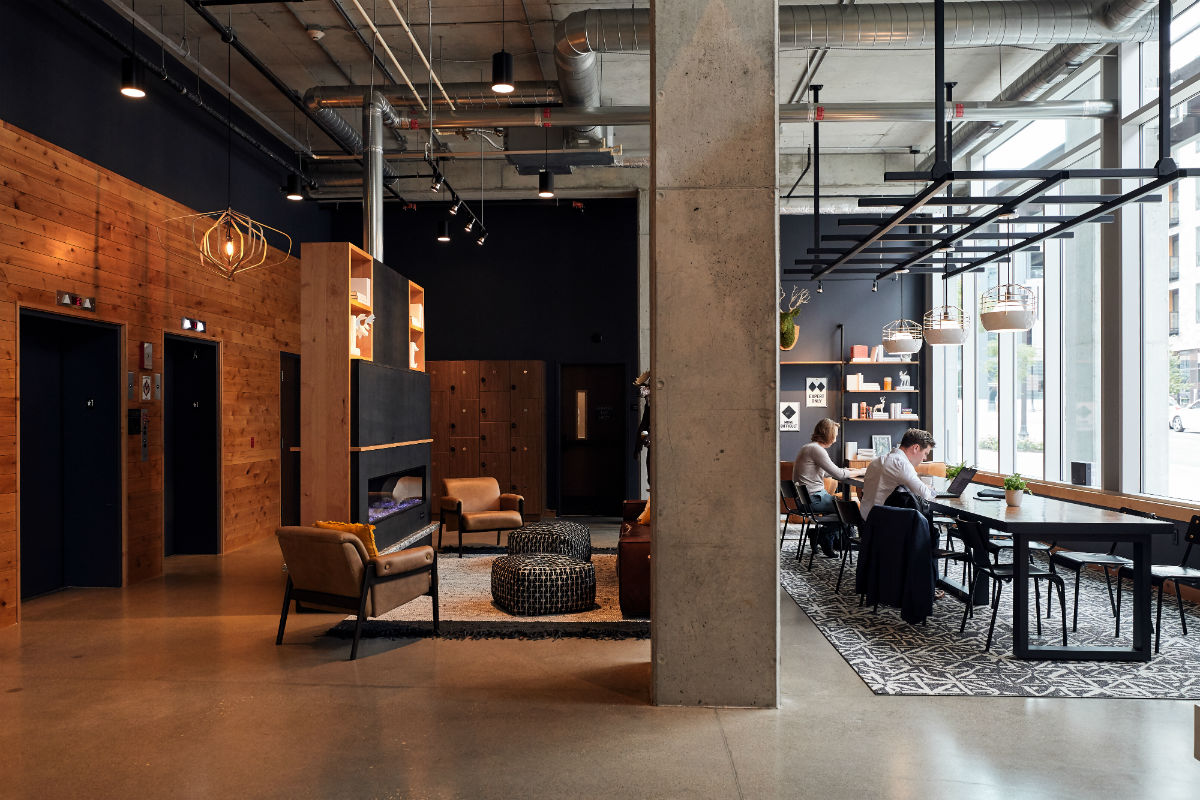At Shea, we pride ourselves on staying on top of what’s happening in design news so that you don’t have to—and we pull what’s smartest and most forward-thinking together to save you the time of sifting through it all. It helps us keep tabs on what’s fresh, inspiring, and happening in the world—and we make a few headlines of our own, too.
“Going Public: 5 Trends Shaping the Design of Hotel Public Areas” – Hotel Designs:
Public spaces in hotels are what shape the hotel experience for guests—from the moment they walk into the entryway and lobby, through the corridors and amenity areas, they’re often what make a hotel unique and give it a distinct personality in a crowded market. And public spaces give an indication of social trends. This story looks at several hotel and hospitality spaces and how their public spaces make a definitive brand statement, from the arrival experience (all hotels should be creating a fabulous, idiosyncratic entry experience) to the incorporation of technology in public spaces (balance between low-contact and high-hospitality is important). Sustainability is a consideration (eco values should be visible in public spaces), flexibility is important (think: multi-functional spaces), and, finally, wellness continues to be of primary importance to hotel guests and needs to be embedded into the structure of these public areas. All of these ideas are interdependent, and they must work together to create the kind of vibe and space that a hotel wants to embody for its guests.
“Green is Our Color: Shea’s Take on Sustainable Design in Workplace and Hospitality” – Shea:
Our latest How We Create article, showing off how Shea incorporates a sustainable mindset into our designs with a unique take on the reduce/reuse/recycle ethos that goes far beyond installing the latest HVAC and lighting systems
“These Are America’s Next Great Food Cities” – Food & Wine:
Food & Wine discusses the growing food cities on the horizon in the United States as the culinary landscape continues to expand. The article breaks down what’s hot in the seven most exciting big cities (Cincinnati, Boise, Omaha, Indianapolis, Jersey City, Tucson, and Charlotte) and what makes them special, as well as four small cities where food is a big highlight (Bozeman, Biddeford, Charlottesville, and Greenville). Each section dives not only into the many restaurants and makers that are changing up what defines culinary in their cities, but discusses their energies, vibes, and what makes them the spots to watch in coming months and years.
“Return to Work Experience: The Reimagining of the Office as a Destination” – Work Design:
This Work Design piece looks at the long impacts of the last few years on the office, and how design has offered solutions to this new reality with fluidity and offering meaningful workplace experiences for companies to attract and retain top talent. Clients will be considering which activities work best in the office (collaboration and learning), versus which can be done anywhere, and offices that embody company values and culture with flexible spaces will be paramount. It’s all about the team dynamic in the office, and employers are doing a lot of experimenting to see what kinds of spaces and configurations work best for them—meaning they need ones that can adapt easily. And tech-compliant and eco-friendly offices are musts to integrate the hybrid workstyle and current thinking about sustainability practices.
“Hotels With Net-Zero Ambitions” – New York Times:
With green construction outpacing traditional building techniques, eco-friendly building is growing especially in the hospitality industry. More and more hotels are looking to be “net-zero” or even “net-positive” in their emissions and waste, and are hoping to educate travelers on the impact that they can have on the planet with more responsibly designed spaces. Net-zero buildings produce as much energy as they use—with electricity, solar panels, thick walls, and low-voltage lighting as some key drivers in energy reduction. Builders are also working to use recycled materials, locally produced furniture, and adding plants throughout their properties. These hotels are also working towards net-zero waste by way of digital messaging and eschewing traditionally disposable materials.
“Life After COVID: Welcome to the World of Hybrid Restaurants” – FSR:
Hybrid restaurants are everywhere post-COVID, having shown their resilient nature and the additional opportunities for restaurateurs to generate revenue streams. The entire concept of the “hybrid restaurant” is still evolving, not just including both full and fast service, but also ghost kitchens, order-and-pay-at-table, digital brands, and drive-thru. Dining out has become more intentional, particularly when it come to sit-down dining, but these convenience-oriented channels make it seem more accessible to consumers. This story looks at the influx of virtual brands into the restaurant experience, but also how marketplaces and retail shops have melded into the dine-in experience.
“We’ll Soon See Office Parks in the Suburbs Catering to Remote and Hybrid Workers” – Forbes:
Suburban office parks have gained prominence in the last few years due to their convenience for workers, easy parking, and an increase in amenities. These markets have seen a major uptick in office leases, and the sector appears to still be growing. This Forbes piece examines how they’ve adapted to really appeal to hybrid and remote workers—in no small part, by taking advantage of the natural surroundings and ample outdoor space that they often have. Suburban offices also tend to have more space generally than urban offices, meaning they can retrofit and give people more space to spread out, a huge bonus after cramped working conditions.
“Emotional Décor: The Trend of Spaces Geared Towards Emotion” – Arch Daily:
Design has long been recognized as having an impact on emotion, and there’s a new focus on “emotional décor” that not only can help produce a desired emotion, but reflects that of those enjoying a space. This piece looks at how color, lighting, acoustics, natural elements, and themed environments can both reflect and have an impact on the mood of the people using the spaces, whether it’s a workplace or a restaurant or hospitality space. Some colors and lighting options, of course, bring more energy, while others produce a calming effect. Biophilia has been proven to have a positive impact on well-being. And the acoustics in a space can certainly give it a more vibrant or more calming feel. It’s all about balance and designing for the desired effect.
“Hazelwood St. Louis Park Wins Minnesota Real Estate Journal Award” – Shea:
Hazelwood St. Louis Park has been honored with the Restaurant Design award by the Minnesota Real Estate Journal, and this story includes information on all the nominees and winners as well as more on our project
“The Great Restaurant Name Vibe Shift” – Bon Appetit:
Restaurant names and brands often get stuck in a particular trend for too long—the “X and Y” names of the mid-2010s, for example, a single word, incorporating ingredient names from other languages, or playing with capitalization or grammar and symbols. This Bon Appetit piece examines the naming and branding trends of the last several years, and what goes into creating a brand with lasting power, versus what’s hot at the moment, but will still be present in the zeitgeist. It also discusses the role of the name in telling the restaurant’s story as a whole, and what naming trends seem to be on the rise in the industry.
April 29, 2022
Curated by Shea: April

